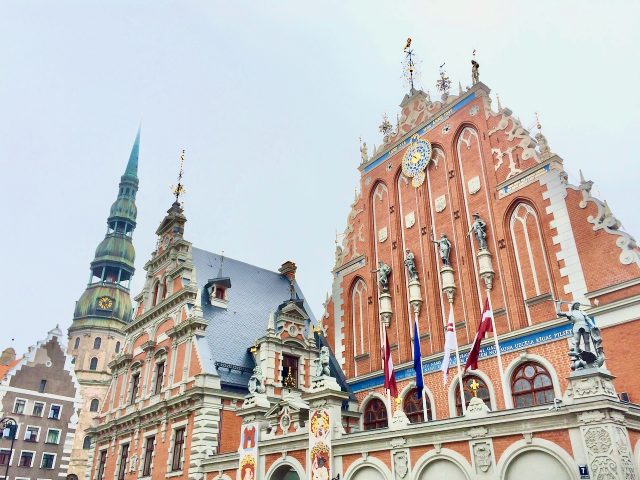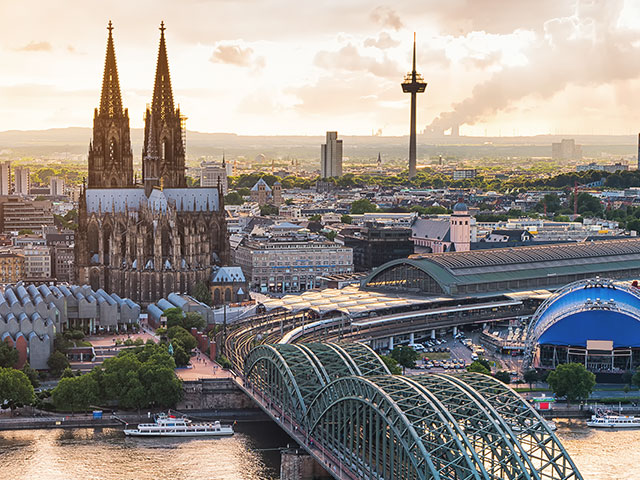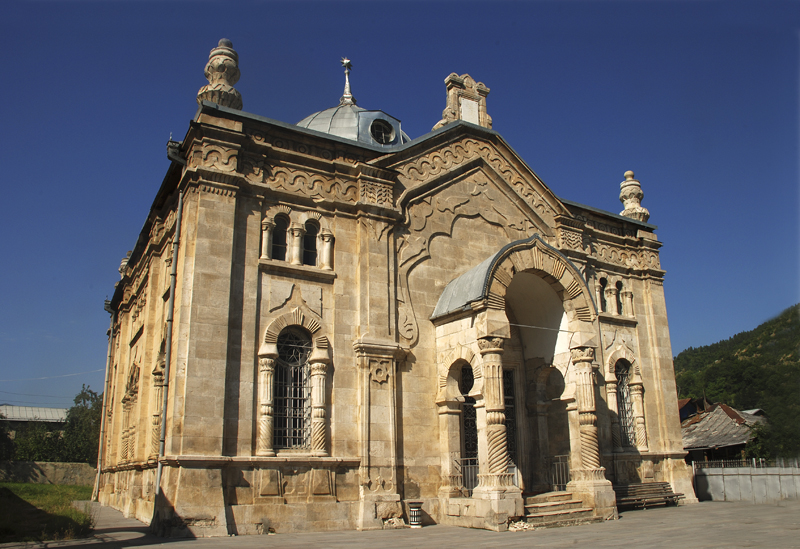.jpg) Chiatura (ჭიათურა in Georgian, Чиатура in Russian) is
a 12,803
inhabitants town by the river Qvirila, in the western part of Georgia.
It's the second biggest town of the region of Imereti, being one of the main extraction points of manganese in the Caucasus since the 19th century. Chiatura
has recently become one of Georgia’s most popular offbeat destinations,
mostly because of its Soviet atmosphere and its mining history.
Chiatura (ჭიათურა in Georgian, Чиатура in Russian) is
a 12,803
inhabitants town by the river Qvirila, in the western part of Georgia.
It's the second biggest town of the region of Imereti, being one of the main extraction points of manganese in the Caucasus since the 19th century. Chiatura
has recently become one of Georgia’s most popular offbeat destinations,
mostly because of its Soviet atmosphere and its mining history.
How do I arrive to Chiatura?
Chiatura is well connected with other towns in Georgia. - Train:
there are trains that arrive to Chiatura from Kutaisi and from Tbilisi.
- Bus: there are daily marshutkas from places like Kutaisi (via Zestaponi), and Tbilisi.
- Car:
if you rented a car, from Chiatura it can be reached Zestaponi (aprox. 50 minutes), Kutaisi (aprox. 1 hour 20 minutes), Surami and Khashuri (aprox. 1 hour 30 minutes), Gori (aprox. 1
hour 45 minutes), Vani (aprox. 1 hour 50 minutes), Borjomi (aprox. 2 hours) in Borjomi-Kharagauli National Park, or Ambrolauri (aprox. 2 hours 20 minutes).
History
The Georgian poet Akaki Tsereteli explored the area in search of manganese and iron ores, discovering deposits in the area in 1879. It was discovered that there are several layers of commercially exploitable manganese oxide, peroxide and carbonate, and the state set up the JSC Chiaturmanganese company to manage and exploit the huge deposit. The company developed a rail link to transport manganese ore to the ferro-alloy plant in Zestaphoni (operated today by Georgian Railways and fully electrified), and it was the largest manganese ore mining center in the world before WW1. During the 1905 Russian Revolution Chiatura was the only Bolshevik stronghold in mostly Menshevik Georgia, with 3,700 miners working 18 hours a day (sleeping in the mines and with no baths). Joseph Stalin persuaded them to back Bolshevism during a debate with the Mensheviks and the mine owners actually sheltered him (as Stalin destroyed mines whose owners refused to pay up). Miners went on a successful 55-day strike in 1913 (demanding an 8-hour day, higher wages and no more night work), supported by fellow strikers in Batumi and Poti. In 1924, the city was the starting point of the August Uprising in Georgia (last major rebellion against the rule of the Bolsheviks in the southern Caucasus). Chiatura is currently the seat of the Archbishop of Chiatura and in 1989 it reached the milestone of 30,000 inhabitants. Today the originally high-quality deposits are almost exhausted.
What can I visit in Chiatura?
These are Chiatura's main attractions:
Chiatura Cable Car: network of rusty cable cars, originally built in the 1950s to transport workers to the manganese mines in the mountains of Chiatura (althogh even families not working in the mines needed the cars to reach their homes at the upper levels), that are today the main attraction in town. It provides great views of the Chiatura and at the top, there's an operational mine.
- Chiatura Drama Theater: theater founded in 1894, whose golden age were the 1920s and 1930s (staging plays by Shakespeare, Moliere, Lope de Vega, David Kldiashvili, Polycarp Kakabadze and others).
- Pioneers Palace: 20th century abandoned theater designed to mimic Greco-Roman amphitheaters at the top of one of Chiatura's cliffs, probably the most peculiar landmark here. Pioneers Palaces were youth centers in the former Soviet Union that were set up to help children develop acting, performance and other creative work, as well as political indoctrination. The visitor has to be careful because it seems to be deteriorating rapidly (although it's thought that the Georgian government plans to invest a lot of money to restore it).
- Chiatura Cross: cross located in one of the mountains of Chiatura, from where getting great views of the town.
- Mgvimevi Monastery: Georgian Orthodox monastery that is partly carved into rock that is known because of its rich ornamental sculptures that decorate the exterior of the buildings. Its main feature is a 13th century two-nave basilica whose walls are neatly hewn stone slabs, with a painted 18th century wooden iconostasis and fragments of frescoes (including portraits of the 13th century builder, Ravi eristavi of Racha). It housed several precious church items that are now preserved at the Georgian National Museum. The complex also includes a small hall church, bell-tower, and a circuit wall (today it's a functioning nunnery).
- Only 11 km far from Chiatura it can be visited the impressing Katskhi Pillar. This natural 40 m high limestone monolith (similar to the sandstone pillars of Zhangjiajie, China) has some in its top some church ruins (corresponding to a medieval hermitage from the 9th-10th century) and a new church, even though the top isn't accessible to the public. The visit will consist in stopping at some viewpoints along the way and then looking at the pillar from the bottom. There's a monastery in its bottom that can be explored too.
 |
Chiatura Cable Car
|
 |
Katskhi Pillar
|
 |
Darkveti Church
|
Chiatura is a good starting point to explore the north and northeastern part of Imereti, where it can be visited places such as Darkveti Georgian Orthodox Church. Only 9 km far from Chiatura, this single-nave basilica with an ambulatory with armonious proportions and carved masonry ornamentation on the exterior façades, has its origin in the 10th and 11th centuries. The interior is whitewashed (and therefore, has no trace of painting) but its façades bear carved ornamentations (resembling those of the Savane Georgian Orthodox Church), like a slab with a relief representation of a peacock. Another of its façades bears a number of medieval Georgian inscriptions mentioning the builders of the church. Not far is also located St. Giorgi Georgian Orthodox Church in Koreti, single-nave basilica from the 11th century that keeps some frescoes in its interior (mainly in the alter, in other places they are very damaged) and some old inscriptions in Georgian. There's a cementery next to it too.
.jpg/1280px-Modinakhe_fortress-2_(Photo_A._Muhranoff%2C_2011).jpg) |
Modinakhe Castle
|
Continuing 14 km from Chiatura there's the town of Sachkhere (საჩხერე in Georgian), 6,140 people, in the northern edge of Imereti (not far from the de facto Republic of South Ossetia). In this town focused in farming the visitor may want to stop at Modinakhe Castle, a fortress built in the 1730s by Papuna Tsereteli (feudal lord of Upper Imereti withing the Kingdom of Imereti). It lost its importance and was abandoned when the Russian army took it over (being further damaged by the 1991 earthquake). Despite its dire condition, it still makes a great impression on the visitor because there are beautiful views of the river, as well as Imereti and Racha mountains (and it was renovated in 2019). Old tombs from the Bronze Age and the Antiquity have been found here too. Next to Sachkhere it can be found some other worthy sights, one of them being Savane Georgian Orthodox Church.  |
Savane Church
|
This single-nave basilica from the 11th century has harmonious proportions, an ornamented iconostasis, and exquisite decorative masonry details on the exterior façades. They are all richly ornamented, having carved, notched cornices, window and door frames adorned with carving of Georgian interlaced work, and carved tympani (as well as having several inscriptions too, speaking about the origin of the church). The interior of the Savane church is whitewashed (there is no trace of paintings) but has an impressing iconostasisis. . Another one is Ekhevi Georgian Orthodox Church, 11th century single-nave basilica known for the rich carved masonry ornamentation on the exterior façades (specially the tympani of the north and west doors as well as the window frames). The barrel-vaulted roof of the interior of the church is supported on three arches. Close to this church there's another one: Speti Georgian Orthodox Church,
a small 11th century single-nave hall church, whose main apse is
similar to that at Ekhvevi Church and has its interior covered with
barrel vaulting. .jpg/1280px-Ekhvevi_church_(2).jpg) |
Ekhevi Church
|
Its most recognizable feature is a medieval ornate
iconostasis made of alabaster and stucco (savekept at the Georgian
National Museum in Tbilisi). In the north of Sachkhere are located the Ruins of Jruchi Monastery, ruined monastery founded in the 10th or 11th century, remodeled and rebuilt several times (lastly in 1846), that was almost completely destroyed in the 1991 Racha earthquake (there are plans for its resconstruction). It's placed in the frontier between the regions of Imereti and Racha, dispute between these two duchies over the centuries. It housed many treasured church items (including two illuminated manuscripts of the Gospel books, known as Jruchi I and Jruchi II).
Where can I eat in Chiatura?
Chiatura doesn't have many places to eat so it's better to try somewhere where locals may go or buying food at the supermarket.
 Telavi (თელავი in Georgian, Телави in Russian) is
a 19,599
inhabitants town by the river Telavisrike in the foothills of Tsiv-Gombori Range, eastern part of Georgia.
It's the capital and biggest town of the region of Kakheti. It’s one of the towns in Georgia with most medieval history and the perfect base for exploring Kakheti’s viticultural, historical and architectural riches.
Telavi (თელავი in Georgian, Телави in Russian) is
a 19,599
inhabitants town by the river Telavisrike in the foothills of Tsiv-Gombori Range, eastern part of Georgia.
It's the capital and biggest town of the region of Kakheti. It’s one of the towns in Georgia with most medieval history and the perfect base for exploring Kakheti’s viticultural, historical and architectural riches.
.jpg/1920px-Alaverdi_Cathedral_near_Telavi_(Georgia).jpg)

.jpg/1280px-Tsinandali_(2).jpg)




.jpg/1280px-Nekresi_Monastery._Kvareli_(12).jpg)









 13:07
13:07
 Banknotemaniac
Banknotemaniac
 Posted in:
Posted in: 
.jpg)



.jpg)



.jpg/1280px-Modinakhe_fortress-2_(Photo_A._Muhranoff%2C_2011).jpg)

.jpg/1280px-Ekhvevi_church_(2).jpg)